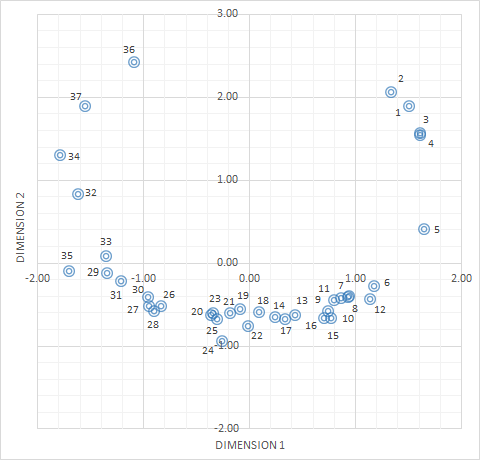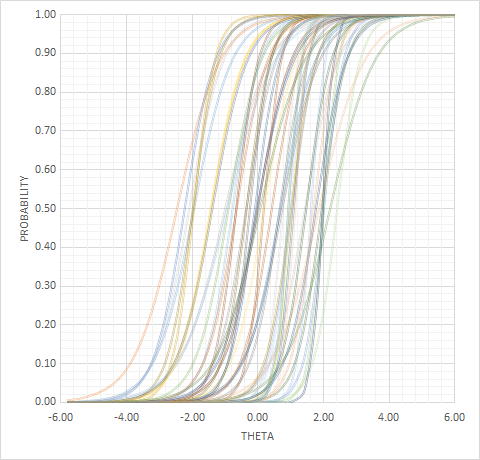What's Next? - Psychometric Properties
The present research aimed to examine and validate the psychometric properties of the "What's Next (WN)" test, a tool inspired by Jouve's EPC test from 2005. This endeavor is significant, as the EPC, which solely used numerical sequences, exhibited exemplary reliability (Cronbach's Alpha = .95) and concurrent validity with established measures of cognitive abilities. The WN, however, introduces items with potentially multiple valid solutions. Employing the data of 506 respondents from the 2009 Cerebrals Society contest, this study assessed the test's internal consistency, arriving at an alpha coefficient of .93, a figure in line with established psychometric guidelines. Validity studies conducted on a modest sample revealed promising correlations with notable measures such as the WAIS-III Full Scale IQ and APM IQ. Additional numerical sequences from the 2010 and 2012 Cerebrals Society contests were incorporated to diversify the WN's measurement range. The primary findings suggest that the WN holds potential as a reliable and valid instrument for cognitive assessment. Further research with more expansive samples is, however, recommended to solidify these preliminary results. The implications of the WN's adaptability, specifically its incorporation of multiple valid answers, might pave the way for a more nuanced understanding of cognitive abilities, pushing the boundaries of traditional psychometric tools.
WN, EPC, Psychometric properties, EPC, Numerical sequences, Multidimensional scaling, Item Response Theory
The What's Next (WN) test draws its lineage from Jouve's EPC test, disseminated in 2005 by ECPA, subsequently subsumed under Pearson Education's aegis, a foremost purveyor of psychological resources in the French academic panorama. The EPC, restricting itself to numerical sequences, proffers two modalities: a succinct, time-bound form and a protracted, unhurried variant. These divergent versions cater to distinct evaluative intents: the former supplies a swift diagnostic tool for gauging reasoning faculties, while the latter delves deeper, probing the profundities of one's cognitive prowess. The EPC's psychometric attributes presented an auspicious panorama. Cronbach's Alpha, gauging reliability, registered at .95 (N = 964). Concurrent validity studies evinced discernible affiliations with other cognitive aptitude assessments, exemplified by correlations of .86 (N = 73) with the Advanced Progressive Matrices (APM; Raven, et al. 1998), within the ambit of .80s (N = 32) with the Weschler Adult Intelligence Scale - Third Edition (WAIS-III; Wechsler, 1997), and .76 (N = 94) vis-à-vis the Scholastic Aptitude Test (SAT, the 1995 - 2005 rendition; Lemann, 1999). Furthermore, a multidimensional scaling (MDS) analysis illuminated an evident item continuum, the intricacies of which could be deciphered solely by discerning the rules requisite for ascertaining veracious answers. Figure 1 delineates what's termed the Guttman's effect (Guttman, 1955), emblematic of unidimensionality manifest in a bifurcated Euclidean expanse. This graphical representation embodies a continuum honoring all disparities in resemblance (Tournois, & Dickes, 1993), as crystallized through the Alternating Least Squares Scaling (ALSCAL; Young, et al., 1980) methodology.

The WN test, while echoing item structures inherent in the EPC, introduces an intricacy: numerous items entertain the plausibility of multiple correct solutions. For the 2009 iteration of the Cerebrals Society Contest, a collection of fifty such items coalesced under the moniker What's Next?. In the contemporary review, answer scripts from 506 respondents facilitated explorations into the metric of internal consistency. The gleaned findings evinced commendable reliability, substantiated by an alpha coefficient registering at .93, which aligns assiduously with psychometric canons (Aiken, 2000; Nunnally & Bernstein, 1994). Parallelly, the application of Item Response Theory (IRT; van der Linden & Hambleton, 1997) illuminated satisfactory item-wise curves. Figure 2 elucidates these curves.

Regarding validity studies, the ensuing indices were procured: .83 (N = 18) in tandem with the WAIS-III Full Scale IQ, .80 vis-à-vis the WAIS-III Performance IQ, .92 in correlation with the WAIS-III Matrices subtest, and .91 concomitant with the APM IQ (N = 21; raw indices transmuted to IQs utilizing Paul, 1985, normative data). These coefficients, albeit indicative, were gleaned from diminutive samples and hence mandate judicious interpretation. Nonetheless, their elevated nature intimates the WN's commendable predictive validity.
In an endeavor to augment the evaluative breadth, the updated WN has subsumed an additional 31 numerical sequences, originary from the 2010 and 2012 iterations of the Cerebrals Society contests.
Conclusion
In elucidating the psychometric properties of the What's Next (WN) test, it emerges that this instrument has robust attributes, drawing inspiration from Jouve's EPC test. The WN exhibits commendable internal consistency with an alpha coefficient registering at .93, making it a reliable tool in line with standard psychometric recommendations. Concomitantly, its validity is underscored by notable figures when juxtaposed with other renowned tests like the WAIS-III. However, the small sample sizes utilized warrant prudence in wholly embracing these results.
The implications of these findings are multifarious. For one, the WN could potentially serve as a versatile tool in the field of cognitive ability assessment, especially given its novel approach of accommodating multiple valid answer keys for several items. This flexibility could make the test more adaptive and better suited to evaluate a wider range of cognitive processes. Nonetheless, future endeavors would benefit from an expansion of the sample size to fortify the validity claims. Additionally, an exploration of the potential impact of cultural and linguistic factors on test performance would be sagacious, to ensure the universality of the instrument.
